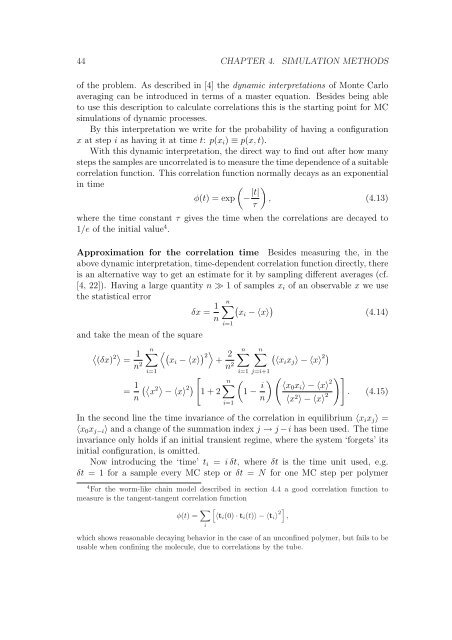Polymers in Confined Geometry.pdf
Polymers in Confined Geometry.pdf
Polymers in Confined Geometry.pdf
Create successful ePaper yourself
Turn your PDF publications into a flip-book with our unique Google optimized e-Paper software.
44 CHAPTER 4. SIMULATION METHODS<br />
of the problem. As described <strong>in</strong> [4] the dynamic <strong>in</strong>terpretations of Monte Carlo<br />
averag<strong>in</strong>g can be <strong>in</strong>troduced <strong>in</strong> terms of a master equation. Besides be<strong>in</strong>g able<br />
to use this description to calculate correlations this is the start<strong>in</strong>g po<strong>in</strong>t for MC<br />
simulations of dynamic processes.<br />
By this <strong>in</strong>terpretation we write for the probability of hav<strong>in</strong>g a configuration<br />
x at step i as hav<strong>in</strong>g it at time t: p(xi) ≡ p(x, t).<br />
With this dynamic <strong>in</strong>terpretation, the direct way to f<strong>in</strong>d out after how many<br />
steps the samples are uncorrelated is to measure the time dependence of a suitable<br />
correlation function. This correlation function normally decays as an exponential<br />
<strong>in</strong> time<br />
<br />
φ(t) = exp − |t|<br />
<br />
, (4.13)<br />
τ<br />
where the time constant τ gives the time when the correlations are decayed to<br />
1/e of the <strong>in</strong>itial value 4 .<br />
Approximation for the correlation time Besides measur<strong>in</strong>g the, <strong>in</strong> the<br />
above dynamic <strong>in</strong>terpretation, time-dependent correlation function directly, there<br />
is an alternative way to get an estimate for it by sampl<strong>in</strong>g different averages (cf.<br />
[4, 22]). Hav<strong>in</strong>g a large quantity n ≫ 1 of samples xi of an observable x we use<br />
the statistical error<br />
and take the mean of the square<br />
(δx) 2 = 1<br />
n 2<br />
δx = 1<br />
n<br />
n xi − 〈x〉 2 <br />
i=1<br />
= 1 2<br />
x<br />
n<br />
<br />
− 〈x〉<br />
2<br />
1 + 2<br />
n <br />
xi − 〈x〉 <br />
i=1<br />
+ 2<br />
n 2<br />
i=1<br />
n<br />
n<br />
i=1 j=i+1<br />
〈xixj〉 − 〈x〉 2<br />
(4.14)<br />
n<br />
<br />
1 − i<br />
<br />
n<br />
<br />
〈x0xi〉 − 〈x〉 2<br />
〈x2 〉 − 〈x〉 2<br />
<br />
. (4.15)<br />
In the second l<strong>in</strong>e the time <strong>in</strong>variance of the correlation <strong>in</strong> equilibrium 〈xixj〉 =<br />
〈x0xj−i〉 and a change of the summation <strong>in</strong>dex j → j −i has been used. The time<br />
<strong>in</strong>variance only holds if an <strong>in</strong>itial transient regime, where the system ‘forgets’ its<br />
<strong>in</strong>itial configuration, is omitted.<br />
Now <strong>in</strong>troduc<strong>in</strong>g the ‘time’ ti = i δt, where δt is the time unit used, e.g.<br />
δt = 1 for a sample every MC step or δt = N for one MC step per polymer<br />
4For the worm-like cha<strong>in</strong> model described <strong>in</strong> section 4.4 a good correlation function to<br />
measure is the tangent-tangent correlation function<br />
φ(t) = <br />
〈ti(0) · ti(t)〉 − 〈ti〉 2<br />
,<br />
i<br />
which shows reasonable decay<strong>in</strong>g behavior <strong>in</strong> the case of an unconf<strong>in</strong>ed polymer, but fails to be<br />
usable when conf<strong>in</strong><strong>in</strong>g the molecule, due to correlations by the tube.













